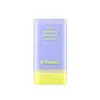What's inside
What's inside
 Key Ingredients
Key Ingredients

 Benefits
Benefits

 Concerns
Concerns

 Ingredients Side-by-side
Ingredients Side-by-side

Methyl Methacrylate Crosspolymer
Polyethylene
AbrasiveCaprylyl Methicone
Skin ConditioningEthylhexyl Palmitate
EmollientCoco-Caprylate/Caprate
EmollientDicaprylyl Carbonate
EmollientSynthetic Fluorphlogopite
Dibutyl Adipate
EmollientButyloctyl Salicylate
Skin ConditioningNeopentyl Glycol Diheptanoate
EmollientDiethylamino Hydroxybenzoyl Hexyl Benzoate
UV FilterVinyl Dimethicone/Methicone Silsesquioxane Crosspolymer
Ethylhexyl Triazone
UV AbsorberOzokerite
Emulsion StabilisingVinyldimethicone
Polysilicone-15
UV FilterBis-Ethylhexyloxyphenol Methoxyphenyl Triazine
Skin ConditioningBakuchiol
AntimicrobialCeresin
Emulsion StabilisingGlyceryl Caprylate
EmollientPolyglyceryl-4 Diisostearate/Polyhydroxystearate/Sebacate
EmulsifyingTriethoxycaprylylsilane
4-Terpineol
MaskingTocopherol
AntioxidantNiacinamide
SmoothingAscorbic Acid Polypeptide
AntioxidantCaffeine
Skin ConditioningWater
Skin ConditioningButylene Glycol
HumectantGlycerin
Humectant1,2-Hexanediol
Skin ConditioningCaprylyl Glycol
EmollientNonapeptide-1
Skin ConditioningAcetyl Hexapeptide-8
HumectantCopper Tripeptide-1
Skin ConditioningTripeptide-1
Skin ConditioningPalmitoyl Tetrapeptide-7
Skin ConditioningPalmitoyl Tripeptide-1
Skin ConditioningPalmitoyl Pentapeptide-4
Skin ConditioningHexapeptide-9
Skin ConditioningMethyl Methacrylate Crosspolymer, Polyethylene, Caprylyl Methicone, Ethylhexyl Palmitate, Coco-Caprylate/Caprate, Dicaprylyl Carbonate, Synthetic Fluorphlogopite, Dibutyl Adipate, Butyloctyl Salicylate, Neopentyl Glycol Diheptanoate, Diethylamino Hydroxybenzoyl Hexyl Benzoate, Vinyl Dimethicone/Methicone Silsesquioxane Crosspolymer, Ethylhexyl Triazone, Ozokerite, Vinyldimethicone, Polysilicone-15, Bis-Ethylhexyloxyphenol Methoxyphenyl Triazine, Bakuchiol, Ceresin, Glyceryl Caprylate, Polyglyceryl-4 Diisostearate/Polyhydroxystearate/Sebacate, Triethoxycaprylylsilane, 4-Terpineol, Tocopherol, Niacinamide, Ascorbic Acid Polypeptide, Caffeine, Water, Butylene Glycol, Glycerin, 1,2-Hexanediol, Caprylyl Glycol, Nonapeptide-1, Acetyl Hexapeptide-8, Copper Tripeptide-1, Tripeptide-1, Palmitoyl Tetrapeptide-7, Palmitoyl Tripeptide-1, Palmitoyl Pentapeptide-4, Hexapeptide-9
Diphenylsiloxy Phenyl Trimethicone
Skin ConditioningParaffinum Liquidum
EmollientOctocrylene
UV AbsorberHydroxystearic Acid
CleansingTriethylhexanoin
MaskingMethyl Methacrylate Crosspolymer
PEG/PPG-9/2 Dimethyl Ether
Skin ConditioningEthylhexyl Salicylate
UV AbsorberHydrogenated Polydecene
EmollientC12-15 Alkyl Benzoate
AntimicrobialButyl Methoxydibenzoylmethane
UV AbsorberDiethylamino Hydroxybenzoyl Hexyl Benzoate
UV FilterDiisopropyl Sebacate
EmollientDibutyl Lauroyl Glutamide
Skin ConditioningBis-Ethylhexyloxyphenol Methoxyphenyl Triazine
Skin ConditioningPolyamide-8
EmollientTriisostearin
Skin ConditioningSilica Dimethyl Silylate
EmollientArgania Spinosa Kernel Oil
EmollientPEG/PPG-14/7 Dimethyl Ether
Skin ConditioningTocopheryl Acetate
AntioxidantLecithin
EmollientBioflavonoids
Skin ConditioningTocopherol
AntioxidantBHT
AntioxidantSimethicone
EmollientPEG-6
HumectantPentaerythrityl Tetra-Di-T-Butyl Hydroxyhydrocinnamate
AntioxidantSilica
AbrasiveParfum
MaskingDiphenylsiloxy Phenyl Trimethicone, Paraffinum Liquidum, Octocrylene, Hydroxystearic Acid, Triethylhexanoin, Methyl Methacrylate Crosspolymer, PEG/PPG-9/2 Dimethyl Ether, Ethylhexyl Salicylate, Hydrogenated Polydecene, C12-15 Alkyl Benzoate, Butyl Methoxydibenzoylmethane, Diethylamino Hydroxybenzoyl Hexyl Benzoate, Diisopropyl Sebacate, Dibutyl Lauroyl Glutamide, Bis-Ethylhexyloxyphenol Methoxyphenyl Triazine, Polyamide-8, Triisostearin, Silica Dimethyl Silylate, Argania Spinosa Kernel Oil, PEG/PPG-14/7 Dimethyl Ether, Tocopheryl Acetate, Lecithin, Bioflavonoids, Tocopherol, BHT, Simethicone, PEG-6, Pentaerythrityl Tetra-Di-T-Butyl Hydroxyhydrocinnamate, Silica, Parfum
Ingredients Explained
These ingredients are found in both products.
Ingredients higher up in an ingredient list are typically present in a larger amount.
You might know this ingredient as Tinosorb S or Bemotrizinol. It is a UV filter that covers both UVA and UVB rays.
This ingredient has two peak UV absorption peaks ( 310 and 340 nm) and is able to absorb both UV-A and UV-B rays. This ingredient works by preventing UV rays from reaching and damaging your skin.
On top of that - it is highly photostable and helps prevent the photodegration of other sunscreen ingredients such as avobenzone.
Tinosorb S is allowed in the EU, Australia, and Asia. It is close to being approved by the FDA and we'll hopefully get this ingredient in the U.S. by late 2025.
Fun fact: Tinosorb S is the most effective UV absorber at maximum concentration (measured by SPF) permitted in the EU.
This ingredient is oil-soluble, so your oil-cleansers will take this right off at night.
Learn more about Bis-Ethylhexyloxyphenol Methoxyphenyl TriazineDiethylamino Hydroxybenzoyl Hexyl Benzoate (DHHB) is a chemical UV-A absorber. It is formulated for high UVA protection (320-400 nm).
DHHB is well-liked for:
DHHB has been approved by the EU, Japan, Taiwan, and South America for use up to 10%. Unfortunately, it has not been approved for use in the US or Canada due to slow regulatory processes.
This ingredient is soluble in oils, fats, and lipids.
Learn more about Diethylamino Hydroxybenzoyl Hexyl BenzoateThis ingredient comes as a powder made up of small, porous, microbeads. It is used to add a silky feel to products and also helps absorb oil.
Tocopherol (also known as Vitamin E) is a common antioxidant used to help protect the skin from free-radicals and strengthen the skin barrier. It's also fat soluble - this means our skin is great at absorbing it.
Vitamin E also helps keep your natural skin lipids healthy. Your lipid skin barrier naturally consists of lipids, ceramides, and fatty acids. Vitamin E offers extra protection for your skin’s lipid barrier, keeping your skin healthy and nourished.
Another benefit is a bit of UV protection. Vitamin E helps reduce the damage caused by UVB rays. (It should not replace your sunscreen). Combining it with Vitamin C can decrease sunburned cells and hyperpigmentation after UV exposure.
You might have noticed Vitamin E + C often paired together. This is because it is great at stabilizing Vitamin C. Using the two together helps increase the effectiveness of both ingredients.
There are often claims that Vitamin E can reduce/prevent scarring, but these claims haven't been confirmed by scientific research.
Learn more about Tocopherol